« Overland Australia - Update 61 | Main | Overland Australia - Update 63 »
October 10, 2001
Overland Australia - Update 62
FROM THE TRAIL
October 10, 2001
From Jason:
Victoria River Roadhouse, 200kms West of Katherine on the Victoria River.
“Well, its not exactly human power, but it certainly beats the hell out of pedalling for a change. Just have to hope no one takes a photo of me to use as blackmail!”
This was the guilt-ridden thought that popped into my head (only briefly might I add) as I climbed into the saddle of a beautiful thoroughbred gelding kindly lent me to take some video footage of the herd of cattle we were following.
April, John and I had left the rest of the group at Limestone Gorge in Gregory National Park for the weekend, driving 120 kilometres to Moolooloo Station with the intention of doing some filming on the topic of ‘Cattle Ranching’ for our Discovery Zone series (a CD Rom for use predominantly in UK classrooms). We were now tailing some 500 head of ‘weaner’ calves 23 kilometres to a yard where they would be ‘drafted’ (sorted) and put out into a different paddock to the one they’d been born and raised in.
“You’re familiar with horses?” Tak – John’s old friend from Broken Hill - asked me almost apologetically as he pulled up alongside. Outback Australians seem to be that much more polite compared to their more direct and often coarser town cousins. Maybe it has something to do
with the reticence I’ve noticed people have out here. They say less and when they do it’s always with a lowered voice, as if to save any excess energy in this hot, dry climate. They also seem to give you the benefit of the doubt when first they meet you, rather than make the instant assumption that you’re an idiot.
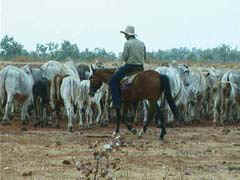
The last time I’d ridden a horse was probably before leaving the UK. But even after 7 years it all came back to me quickly – just like riding abike.
“I was brought up on a horse”, I replied without exaggeration, sinking comfortably into the deep Australian stock saddle. English saddles are like sitting on a plank of wood in comparison.
“Just making sure”, he replies with the hint of a smile curving up from the left hand side of his mouth. “Maybe the Pom’s moved up a notch,” I think to myself as the horse underneath me broke from a trot into a rolling canter. “A Pom that can ride a horse has to be better than just a Pom”.
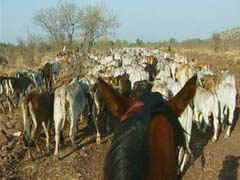
For the next 48 hours we got to sample a little of the life to be had on a Northern Territory Cattle Station; from gnawing dinosaur bones at the Saturday night BBQ to having a cardiac arrest on the toilet following the hasty exit of a large, green frog from the underside of the seat.
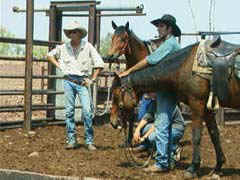
The highpoint however had to be the next afternoon when we were lucky to
experience the art of mustering cattle (gathering together) by helicopter. Dark storm clouds were already forming on the horizon as we drove the rough, 30 km track to the yard where the cattle were being mustered. Heli-mustering is a relatively recently adopted technique of gathering cattle from huge paddocks - several hundred square kilometres in size – into holding pens for necessary maintenance/sorting. The paddock in this case had the added disadvantage - at least from the perspective of being worked by horse-back – of being covered ankle deep in rocks. So mustering by helicopter often not only saves time but ultimately also money (see today’s Maths update).
After making contact on channel 1 on the truck’s UHF radio we met up with Mark Clifford, the Station Manager, who kindly allowed me to go up in one of the choppers to film from the air. After a quick 4-minute up and down – enough time at least to get the aerial shots I needed – the pilot set me down on one of the yard roofs to film the final ‘yarding up’ process of squeezing the mustered cattle the last few hundred yards through a funnel into the holding pens. At this point the heavens decided to open. Exposed on the roof as the rain gathered momentum I kept the video camera rolling for as long as I could before having to cover it with my body to avoid it being completely drenched. And this of course was the point at which the action really started.
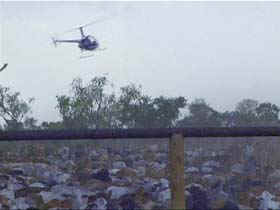
Bear in mind these cattle are mustered only once a year, having human contact for only a few days in every 365. So for all intents and purposes they are as wild as cattle can get. All parties present were then treated in the closing stages to a truly spectacular display of acrobatics as the chopper pilot engaged in an air-to-land dogfight with a rogue mother and calf that had absolutely no interest in joining her colleagues in the pens. As the clattering machine ducked and weaved just a few feet above the ground to cut the mother from double-backing, spinning first this way then that, the mother cow likewise spun and gyrated to shake off the chopper, occasionally raising her head skyward to shake it in defiance of this airborne threat to her offspring.
Finally the mother’s efforts prevailed and she escaped behind the chopper, her calf managing to barge through the fence to freedom into a neighbouring paddock. “No worries”, said Mark as we all congregated in the pouring rain beside the pens, now filled to the brim with steaming animals. “The ringers will probably pick them up later this week during drafting”.
Half an hour later and we found ourselves labouring our way through the mud back to the homestead, our most excellent Mitsubishi 4WD Canter truck doing an amazing job of making forward progress in the black clay soil – now a muddy quagmire – where other trucks would surely fail.
After a cup of tea and some Anzac biscuits kindly given to us by Barbara- the station cook - we bid our farewells and started the long drive back to the rest of the team at Limestone Gorge.
On the way we stopped at Timber Creek to check if Git had caught her
bus to Katherine and ultimately Alice Springs, which it turned out she had.
We’d dropped her at the Wayside Inn on our way out to Moolooloo the
Friday afternoon.
Sadly she had to make the decision to drop out of the expedition for health reasons. As many of you who have been following the updates will know, Git has been wrestling with chronic back pain since leaving Alice Springs 4 weeks ago. It just made no sense for her to continue riding in the support truck.
It’s never good to lose a team member, for whatever reason. Losing Git is especially hard since she has become such an integral part of the group in such a short time. We shall miss her for our remaining time out here: her quick, dry wit, willingness to throw herself into any new challenge that might present itself, and her ability to cook thousands of perfect pancakes in 100+ degree temperatures while being attacked from all sides by squadron after squadron of voracious flies.
I only hope she found a little of what she got off the bus on the Plenty Highway to find. I remember her reply when asked why she wanted to come along (at the time she was being interviewed to join the team in the middle of the road, in the sweltering midday sun, beside a decomposing kangaroo). “The bus thing just isn’t cutting it for me” came the reply. "I need something more . . .”.
So long Git, and I think I can speak for all of us when I wish you the very best for wherever you decide to steer your life next. Like we discussed on that sandy section leading up towards Derwent Station, a few day’s before hitting the Tanami. Live your heart’s deepest desires - keep searching for that song you were born to sing.
Jason
*Aboriginal place-names for the day:
UMBERUMBERKA: A Rat Hole
YONGERLOCELKUCUP: A Plain where the Kangaroos Dance
YONGERMORANELYEIRUP: A Place where Kangaroos Scratch Holes in the
Ground
GOOTERING: A Rosella Parrot
MILBRULONG: A Rosella Parrot
JUMPINPIN: Root or Sucker of the Pandanus Tree, used for sucking
Our Educational Theme for today is 'Cattle Ranching'.
CLASSROOM ACTIVITIES >>
Maths
History
Education for Sustainable Development (ESD)
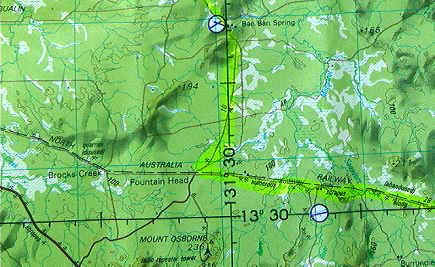
Posted on October 10, 2001 3:40 PM